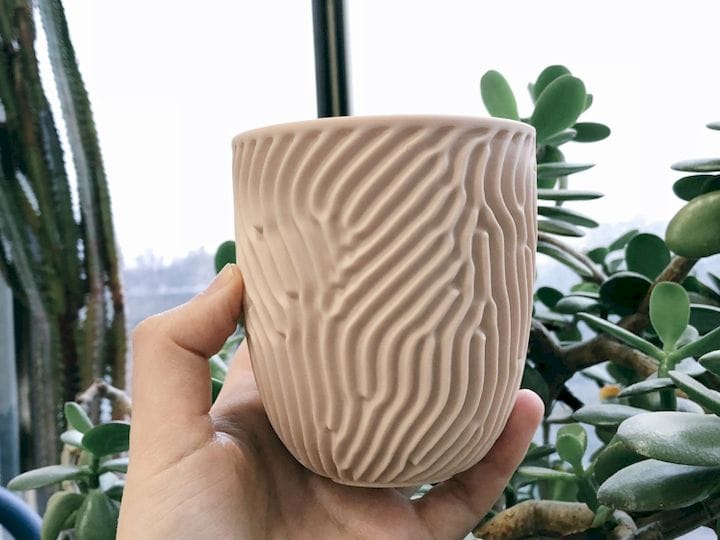![The Coral Cup [Source: Nervous System]](https://fabbaloo.com/wp-content/uploads/2020/05/image-asset_img_5eb0a37fba524.jpg)
This week’s selection is the highly tactile Coral Cup by Nervous System.
The algorithmic masterminds at Massachusetts-based Nervous System have designed an incredible ceramic item they call the “Coral Cup”. It’s a simple sans-handle cup suitable for hot drinks, yet its design is anything but simple.
Their goal was to produce a cup that mimics brain coral, with wiggly surface lines that start and stop randomly. The effect is both visual and tactile as you pick up the unusual cup.
They did not use an actual brain coral as the model for this product, but instead used actual brains – to develop an algorithm that could produce the unusual surface. This is standard operating procedure for the company, who have produced quite a number of highly unusual mathematically generated 3D prints.
![Coral Cup designs [Source: Nervous System]](https://fabbaloo.com/wp-content/uploads/2020/05/image-asset_img_5eb0a38019668.jpg)
They explain how the surface generation occurs:
“The cup’s texture is generated by a simulation of reaction-diffusion, a mathematical model of pattern formation in biological systems that’s been used to explain the skin patterns of animals from the spots on tropical fish to the stripes of zebras. We can affect the simulation by changing reaction rates, scale, and the direction of diffusion through space. We’ve been designing objects with reaction-diffusion systems since 2010.”
What is new for the company is how they are producing the cup. Previous ventures of this type were outsourced by Nervous System to ceramic manufacturers. However, in this iteration the company wanted more control over production and they set upon establishing an in-house ceramic factory.
![Printing part of a mold for the Coral Cup [Source: Nervous System]](https://fabbaloo.com/wp-content/uploads/2020/05/image-asset_img_5eb0a38067a15.jpg)
The process they use to produce the cups is multi-step and does not actually 3D print the cup itself. They explain how it’s made:
“Instead of 3D printing a copy of the cup, we 3D print parts which can be used as a mold for a mold of a mold. Confusing right? We cast silicone rubber into the 3D printed mold parts. The rubber parts are master molds that we then use to cast plaster parts. The plaster parts are used to cast the ceramic slip, a liquid pourable clay. The process we use is called slipcasting, which is a neat casting process for hollow ceramic forms. When we pour the slip into our plaster molds, the edges dry faster as moisture is quickly wicked away by the porous plaster. After about 15 minutes, a hardened skin of porcelain forms, and we pour out the rest of the slip for later use.
The next day we can release the cup from the mold. Since the seam lines follow a ridge of the pattern, they are quickly removed with the swipe of a sponge. The cups are then glazed and fired to cone 6 in an electric kiln. All the slip and glazes are mixed right in our studio.”
![Molding the Coral Cup [Source: Nervous System]](https://fabbaloo.com/wp-content/uploads/2020/05/image-asset_img_5eb0a380acdd8.jpg)
The result is an amazing artistic coral-style cup that is fully usable, unlike many 3D prints. This one is also dishwasher safe. You can now pre-order them for the holiday season at US$40 each.
Via Nervous System











This week’s selection is a 3D printed Coronavirus!